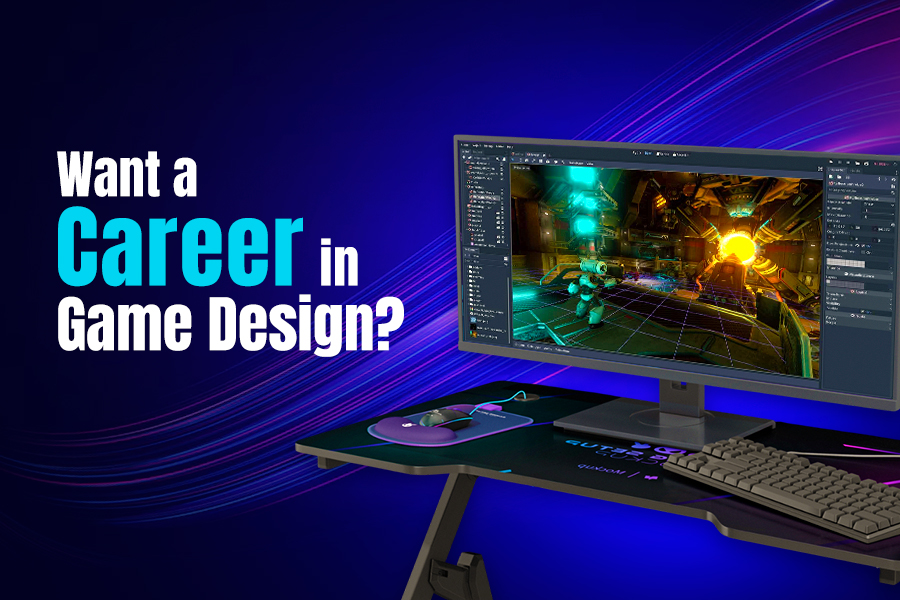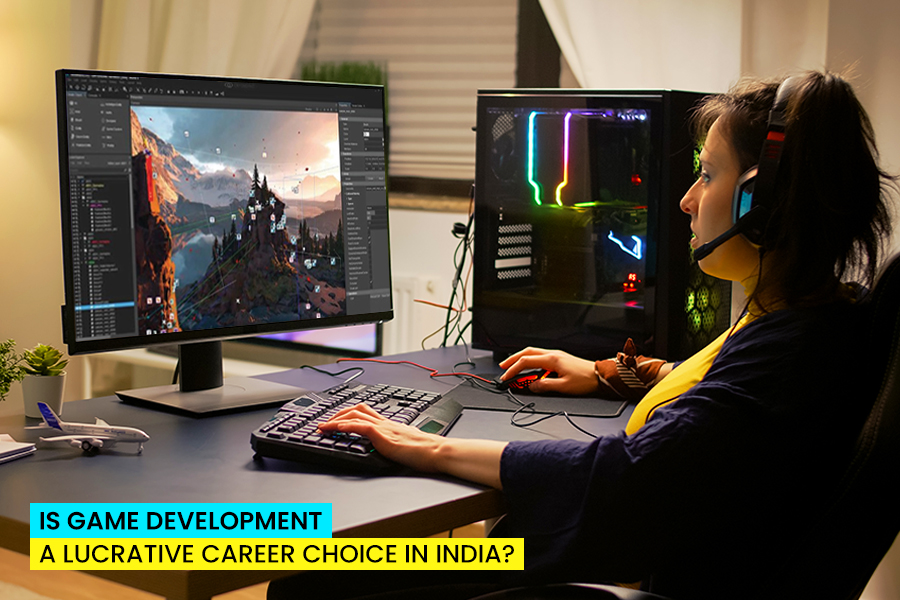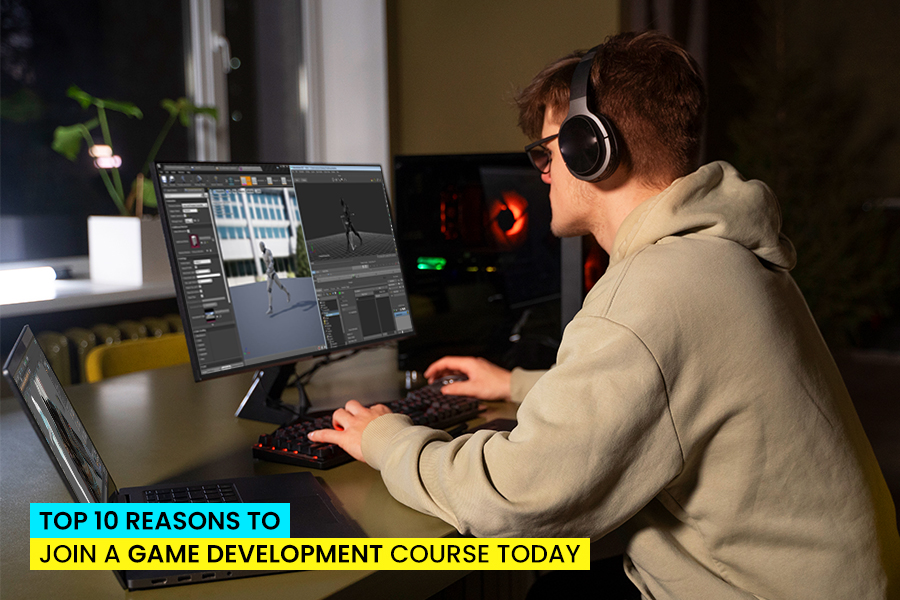
Want a Career in Game Design? Start with Unity 3D Game Design in 2025
Interested in pursuing a career in Game Design? Unsure which course to take?
Game design is the artistic foundation of the video game business. It’s all about defining the players’ experience. From creating characters for the game to organizing levels, establishing rules, constructing narratives, and envisioning game worlds—game designers do it all.
A good game doesn’t merely appear visually appealing. It’s a pleasure to play. Each challenge, each item pickup, and each line of dialogue is part of a deliberate experience. A game designer is responsible for ensuring the experience is seamless, engaging, and enjoyable.
The design establishes the emotional and psychological pulse of gameplay for basic mobile puzzle games or complex action RPGs (Role-Playing Games).
Game design also involves making decisions on game mechanics—what works, what can and can’t be done, how the game unfolds, and how players are rewarded.
While game development requires technical implementation, game design is more concerned with ideas, looks, organization, pacing, and interactivity. That is why software such as Unity 3D Game Design is so valuable, it allows designers to make and refine their vision, usually without having to be programming experts.
As the gaming industry continues to grow, the demand for thoughtful, well-trained designers grows with it. If you are someone who enjoys coming up with creative ideas, deciding how to organize a system, and creating experiences for someone else to enjoy, then game design could be your career.
In 2025, enrolling in a Unity 3D Game Design Course in Kolkata will put you on the path to becoming a Game Designer with a high-paying salary.
What is Unity 3D Game Design?
Unity 3D Game Design uses the popular Unity engine to design, conceptualize, and prototype games. The powerful game engine offers a complete game design ecosystem, especially for designing interactive experiences that take place in a real-time 3D space. Designers use Unity to build environments, design levels, write rules for gameplay and determine how players interact with the game.
What makes Unity 3D Game Design unique is its visual approach to creation. Designers can create game assets through drag-and-drop components. Visual scripting and real-time previews allow them to see their ideas come to life.
While a little knowledge of scripting can support your design workflow when using Unity, it is not mandatory to be successful. This makes Unity a great choice for new designers who want to start from nothing and gain a real understanding of how games come together.
Another reason Unity is used so commonly is its cross-platform compatibility. Whether you’re building for mobile, desktop, console, or even VR, Unity allows you the freedom to create once and deploy anywhere. It’s useful not only for developers but also for designers who want to see their creative efforts displayed across different platforms.
A Unity 3D Game Design Course will teach you to structure game worlds, design player interactions, control the pacing, and use stunning visuals to enhance gameplay. Unity provides instant feedback while you work, which is fundamental to learning and improving.
Taking a Unity 3D Game Design Course in Kolkata means you will learn these skills in one of India’s emerging tech and creative hotspots, with access to mentors, studios, and real industry exposure.
The Market Demand for Game Designers in 2025 in India

1. Booming Gaming Industry
India’s gaming industry is expected to be worth $7.5 billion by the end of 2025. This comprises mobile gaming, PC gaming, console games, and even the indie (independent) game market.
The higher demand for games translates to a greater demand for novel and interesting designs, which means new designers can find ample opportunities here.
2. Mobile-First Gaming Economy
India’s mobile-first user base is expanding, and with it comes the demand for games designed specifically for smaller screens and shorter attention spans. Game designers with a talent for creating fun, lightweight games are particularly in demand.
3. Rise of Independent Game Studios
Independent, smaller studios are springing up all over India. These studios, tend to have smaller teams, with game designers playing important roles in the whole creative process, from conception to shipping.
As Unity 3D Game Design is something that you can do on your own or in small teams, after a good course you will be highly employable.
4. Game Localisation Needs
Indian game developers are now developing region-specific games in local languages, overlaying a cultural aspect within game design. Designers who can create stories, characters, and worlds that resonate with Indian gamers have higher chances of being recruited by top gaming companies.
5. Global Outsourcing of Game Art & Design
India has emerged as a hub for offshoring game design work from international studios. If you are proficient in design software and platforms such as Unity, you can design for global clients without having to move abroad.
6. Design-Driven Recruitment for Tech Startups
Immersive design is needed beyond the gaming world. Even tech startups building AR, VR, or metaverse platforms require designers to craft engaging virtual environments.
Having Unity 3D Game Design & Development skills puts you into a rapidly growing technological field.
Reasons to Enroll in a Unity 3D Game Design Course
Industry-leading Game Developers
Course instructors have several years of experience developing games for commercial sales. They give you valuable insights into how game studios work, what issues teams encounter, and what skills are most required for various job roles in the industry.
Learning by Doing, Not Theory
With Unity, design is hands-on. In a Unity 3D Game Development course, you’ll actually build levels, position objects, adjust interactions, and test in real time. Practical learning like this allows you to grasp concepts quickly and easily.
Advanced Game Design Curriculum
A Unity 3D Game Design Course includes learning material that matches current industry standards and workflows. Sessions emphasize cutting-edge tools, coding methods, and design techniques.
Your skills remain updated and you learn techniques and knowledge in accordance with what studios expect from designers today.
Become Proficient in Design Logic
Great game design is not just about knowing how to use software very well. It’s about figuring out structure, user experience, and balance.
The course will focus on applying a design-first approach across varied projects and platforms.
Networking Events and Industry Meetups
You get the chance to meet and connect with individuals in the field, both professionals and fellow students.
These events are helpful for hearing about opportunities, getting insights from experts, and networking with local gaming professionals.
Modern Learning Environment
You will use the latest hardware and licensed software to work on projects smoothly without technical constraints.
The advanced tools and technology provided during the course will allow you to work in an environment that resembles that of a professional studio.
Portfolio
You will begin to build a portfolio of original projects, highlighting your skills by the end of the course. It is the unquestionable proof of your Unity design skills. You can use your impressive portfolio to highlight the quality and range of your work to future employers.
Placement Assistance and Certification
The Unity 3D Game Design course includes job placement assistance. You will receive support with applications, interview preparation, and finding jobs that suit your skills. The main objective is to ensure you start a career without any worry or confusion.
Plus, the valuable certification you earn will showcase that you have completed a formal, practical learning in Unity Game Design, in accordance with ongoing industry standards.
Is Coding Experience Required for Unity 3D Game Design Course in Kolkata?
You don’t have to be familiar with programming before starting the course. A Unity 3D Game Design course will begin with the basics of C# programming, but it’s taught in a manner that supports designers without scaring them away. The course focuses on creativity, layout, storytelling, and user interaction.
That said, having some general knowledge of games and how they operate can provide you with a slight advantage. Knowing various types of games or what makes a game enjoyable or frustrating is helpful when you start developing your own concepts.
Familiarity with digital tools (like Photoshop or Blender) is a plus, but not required. You’ll learn everything step-by-step. What helps is being curious, observant, and open to feedback.
Game design is about iteration—trying, failing, adjusting, and improving. This is game design for beginners, not a course meant only for those with some experience.
Skills You Will Gain On Completion of the Unity 3D Game Design Course
1. Understand How Games are Constructed
You will begin by grasping a few basic things about how games are constructed from beginning to end. Get familiar with the whole production pipeline, in terms of how ideas are formed, then concepts become art and art becomes playable experiences.
You will understand the various production roles, including artist, designer, and developer, and how they all work together in the video game creation. This foundation will provide context for everything else you learn.
2. Learn the Basics of Game Art
Explore how visual elements, such as light, color, and perspective affect players’ game experiences. You will study how storytelling connects to visuals— what a character looks like and why, how the game world supports gameplay, and what design decisions improve the experience of the game as a whole.
3. Design Game Characters and Environments
Learn how to create original game characters and give them personas, and roles. Understand what makes character design work visually and narratively. Study level design— how to design level layouts, placement of objects, and how design can guide players and challenge them in the game environment.
4. Use Professional 3D Art Software
Get practical experience using industry-recognized software, such as Autodesk Maya, Blender, ZBrush, Substance Painter, Photoshop, and Unity. Experienced instructors will teach you how to navigate each tool and use it in a professional workflow. You will practice creating 3D models, textures, and animations for games.
6. Animate Characters and Bring Them Into the Game
Level up from static models. Step-by-step learn how to rig characters (create bones and joints), animate movement, add lip-sync with audio, and create simple camera animations. Then, import your characters into a game engine and observe their work within an actual game environment.
7. Create a Fully Playable Game Using Unity
Use Unity to bring it all together. Understand how to develop a game world, construct and manage characters, implement gameplay features, and add simple scripts that link various components of your game. You will also be introduced to playtesting, learning how to improve and perfect your game from feedback.
8. Develop a Game Art Portfolio That Demonstrates What You Can Do
All through the course, you will work towards developing your professional portfolio. This consists of your best 3D assets, character animations, and a playable level created in Unity. By the end, you will have a solid body of work that proves your abilities and gets you prepared for internships, employment, or freelance work within the game industry.
Career Options After a Unity 3D Game Design Course
Once you are done with your Unity 3D Game Design course, you have an entire range of careers waiting to be taken on. These are some of the careers that you can take up:
- 3D Modeling Artist
Develop precise 3D models of characters, scenery, and objects employed within the game world.
- Texturing Artist
Give 3D models realistic or stylized textures that bring a visual feel that fits a game’s design.
- Lighting Artist
Create lighting arrangements that boost mood, visibility, and gameplay. Lighting plays a critical role in creating the atmosphere and directing players.
- Rigging Artist
Construct skeletons and movement frameworks for characters so they can be animated correctly.
- 3D Visualizer
Create visualizations of game ideas or levels in 3D to assist teams in planning or pitching ideas before the production process begins.
- Layout Artist
Create the environments, object placement, and camera angles to guide the player’s path smoothly.
- Animators
Animate objects, environmental elements, and characters to give life and movement to the game environment.
- Game Asset Creator
Create and design assets such as props, background objects, vehicles, or weapons that players use.
- Game Level Designer
Design and construct the levels of the game, balancing challenge, pacing, and narrative through smart layout and obstacle placement.
These skills are not limited to game studios. Media firms, Edtech, Adtech, and simulation-based platforms are also looking for individuals with these skills.
Conclusion
If you have always been interested in gaming and want to turn your creativity into a promising career, game design is the ideal opportunity in 2025. With tools like Unity being accessible and easy to use, it is easier than ever to get into designing games. You may be looking for a full-time position or another hobby in your creative repertoire. Either way, a solid, practical course can take you a long way.
Search
I Want to Learn...
Category
Explore OurAll CoursesTransform Your Dreams
into Reality
Subscribe to Our Newsletter
"*" indicates required fields
Similar Reads

Is Game Development a Lucrative Career Choice in India?

 New Year Special Discount Offer - Upto 20% Off on all Course Fees - 43 Seats Available
New Year Special Discount Offer - Upto 20% Off on all Course Fees - 43 Seats Available 





